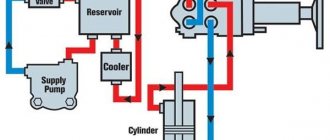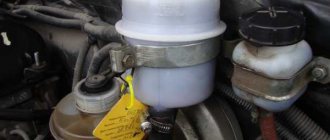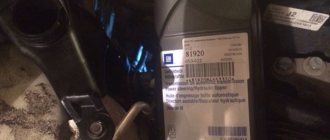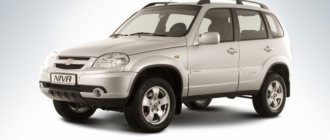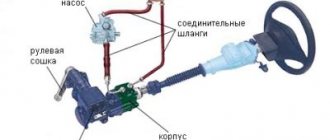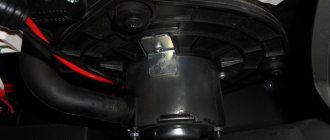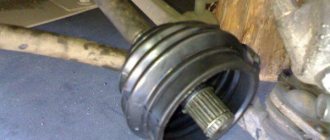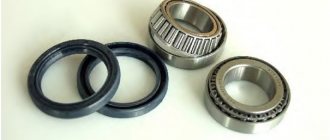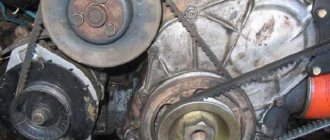In cars with VIN 40005880, the power steering reservoir is filled with Shell Donax TA D-21631, Dexron IID class GM fluid. The expansion tank has a mark in the form of *. Painted with white paint. Cars with VIN 40006248 are filled with Ravenol Dexron IID. The mark in the form of the letter R is painted with white paint. Both fluids are mineral; when replacing with Pentosin Hydraulic Fluid CHF11S, they require double flushing. Pentosin is a green mineral water. Donax / Ravenol – red mineral water.
In principle, automatic transmission oil can be used for power steering. Dexron II and higher. It is usually red. True, you will need to drain everything that is in the power steering system. Since the first half of 2004, the power steering drive system has used Shell Donax TA D-21631, Dexron II D, according to GM classification. Shell Donax TA D-21631 cannot be mixed with oils from other manufacturers. A complete oil change is allowed after flushing the power steering drive system. Shell Donax TA D-21631 and Ravenol Dexron II D cannot be mixed with Pentosin Hidraulik Fluid CHF11S. A complete oil change is allowed after flushing the power steering drive system. Attention! Shell Donax TA D-21631 and Ravenol Dexron II D are recommended for use at temperatures not lower than minus 30° C.
GUR service on Niva Chevrolet
The modern Russian Chevrolet-Niva jeep is equipped with a device that makes it easier for the driver to control the steering mechanism. This is power steering. That is. power steering.
In short, the principle of its operation is as follows:. Hydraulic fluid from the reservoir is supplied to the power steering pump, which rotates through a belt drive due to the rotation of the engine. From there, under high pressure, the amplifier itself is attached to the worm gear. Due to the pressure supplied by the pump, the force applied by the driver to turn the wheel increases several times. As motorists say, the steering wheel can be twisted “with one finger.” But the fluid in the mechanism needs to be replaced from time to time. Our automotive industry does not give a clear time for replacement, but experienced technicians recommend doing it at least once every five years.
What does that require
First of all, you need to determine the brand of the liquid. This can be of two types. Pentosin Hidraulik Fluid CHF11S and Shell Donax TA D-21631 (Dexron 2). Penozin. it's a green liquid. And Dexron is red. Dexron is interchangeable with Ravenol Dexron 2 D.
In general, there are special symbols on the fluid reservoir, which is located on the back of the engine compartment next to the battery. Therefore, if Dexron 2 D is poured into the tank, it is an "R". And if the icon is “,” then this is Dexron 2. Under no circumstances should Pentosin and Dexron be mixed. After washing, only complete replacement is possible.
Reservoir for windshield and brake fluid.
Another filling capacity of the Chevrolet Niva is two glass washer reservoirs, the capacity of which is five and two liters.
This model has two independent braking systems. The working one has a hydraulic drive, the parking one has a mechanical drive. The contours are separated from each other.
The hydraulic drive includes a special tank made for brake fluid.
- DOT-4 brake fluid is suitable for half-liter hydraulic brakes. The product has improved characteristics and has a boiling point of over 235 degrees. Well suited for regions with low ambient temperatures.
- SAEJ1703, FMSS116 are used for the entire hydraulic system and clutch release (0.15 l). The synthetic product provides good lubrication and reduces oxidation at high temperatures.
- The tank lid hatch hinges, door and hood locks require VTV-1 and FIOL-1 greases. Hinges of steering rods and cardan shafts - ShRB-4, Litin 2, Esma.
- The air conditioner also has two tanks. One of them is for oil (0.22 l), the other is for refrigerant (0.650 kg).
Chevrolet Niva reservoirs for refilling liquids and lubricants are quite reliable and convenient when you need to make a replacement.
Various tags and sensors make it possible to carry out control almost immediately, which allows you to avoid an emergency situation.
What tools for preparation
Special tools do not require changing the oil in the power amplifier. One key number 10. Fixed screwdriver. And a container for liquid that will drain. Due to the tightness of the engine compartment, it is best to take a cut plastic bottle. Well, the process itself First, release the clamping cup clamp from the key. Wipe it gently with a cloth. It is necessary that dirt accidentally gets into the tank. Only then carefully unscrew the tank cap using the level indicator. Carefully pour the liquid into the bowl. Using a screwdriver, loosen the hose clamp from the power steering to the tank. This is a drain hose. Hole in tank, connection to remote hose, plug. The hose itself is directed into a container to drain the liquid.
Cooling systems.
The cooling system here is liquid, closed type. This includes a radiator, pump, sensor. thermostat, fan, expansion tank, hoses, etc. The capacity is 8 liters.
The expansion tank is located next to the brake booster. Installed markers allow you to quickly determine the fluid level. It is important that everything is completely sealed, so the inlet and outlet valve monitor and regulate the pressure.
The tubular-plate radiator is made of aluminum and has plastic tanks. Coolant Antifreeze A-40 M for this system is poured through the expansion tank.
Changing Power Steering Oil
oil without problems
in
GUR
. All videos on the page.
Now you need to start the engine, turn the steering wheel left and right several times. The pump squeezes out most of the liquid. Rotate the reservoir one more time and gently hold it at the beginning while pouring new fluid. The hose is directed to a waste container. Rinse until a clean, fresh stream comes out of the hose. You can still turn the steering wheel. Now that you see that the fluid is clean, stop the engine and reinstall the hose. Tighten the hose clamp. Replace the reservoir and secure it securely. Last step. Fill the fluid reservoir with the stylus marks attached to the lid. Okay, tighten the cap.
Transmission
Replacing lubricant in machine engines is a simple procedure that you can perform yourself, without the help of specialists. The main thing in this matter is to know what kind of oil and where to fill it.
If we talk about the VAZ 4x4 2121 Niva, then the engine should contain approximately 3.75 liters of oil product. Moreover, you need to fill in one brand of oil; different types cannot be mixed. Otherwise, the entire proportion will be ruined.
When mixing a mineral and a synthetic sample, the result will be a substance of low quality. It forms pieces that are not acceptable for the normal operation of the unit.
Replacing lubricating fluids is provided not only for the engine, but also for other components of the VAZ 4×4 2121 Niva. Places, filling volumes, names of oils are given in the table.
Page 68
The Niva 4x4 transmission system has the following filling volumes:
- transfer case - 0.79 l;
- gearbox - 1.6 l;
- rear axle - gearbox - 1.3 l;
- front axle - crankcase - 1.15 l;
- steering column - crankcase - 0.18-0.2 l.
| Lower limit of ambient temperature, °C | -15 | -25 | -25 | -30 | -40 |
| Upper limit of ambient temperature, °C | 45 | 45 | 35 | 45 | 35 |
| SAE lubricant viscosity grade | 85W-90 | 80W-90 | 80W-85 | 75W-90 | 75W-80 As stated in the operating instructions, transmission lubricants must be changed once every 30 thousand km. mileage At the same time, replacement is not provided for in the steering mechanism housing, only an addition through the top plug. The “native” oil for Zhiguli transmission units is considered to be TAD17I. Transmission oils have good penetrating ability. Therefore, poorly clamped plugs and worn gaskets of units begin to gradually leak lubricant. In such situations, it is allowed to add oil of the same viscosity class and, preferably, the same manufacturer. If you do not top up during a leak, the lubricant level in the unit will decrease, which will lead to accelerated wear of expensive mechanisms. |
Previous posts from the category: NIVA CHEVROLLE
Fuel pump design The Chevrolet Niva fuel pump is located in a gas tank and is combined into a common module with a fuel pressure regulator and a gasoline level indicator. The electric submersible pump has a commutator motor.
Changing the chain tensioner on a Chevrolet Niva
Hydraulic Chain Tensioner The chain tensioner is one of the parts of the gas distribution system that relates to the engine camshaft. It is located in front of the “head” of the cylinder block under the cooling system nozzle.
Main elements of the system
The largest and most basic element is the fuel tank, but the total number reaches sixteen. Their volumes vary greatly.
- They are necessarily included in the engine cooling and lubrication systems.
- Axle housings and gearboxes are also extremely important for safety during travel.
- Chevrolet Niva filling tanks include power steering systems and hydraulic brake lines, front and rear shock absorbers.
- An integral part are tanks for windshield washer and air conditioning.
Bottom line
You need to change the oil, you need to do it on time and use high-quality consumables. The longevity of the engine largely depends on the issues that are associated with this important component. Don’t skimp on such little things, because a major overhaul of your car’s power unit will cost tens of times more than regularly replacing high-quality engine filler.
There are not so few links in this chain, and this always means that not everything is as simple as you would like. But statistics show, and reviews from car enthusiasts confirm, that counterfeit oil is becoming increasingly rare on store shelves, and it’s not worth chasing after saving money when shopping on spontaneous, semi-legal auto parts markets.
It is also worth paying tribute to the Chevrolet Niva model itself. The car is very unpretentious and can forgive some mistakes when it comes to changing the oil, but you should not look for the ultimate strength in this matter in your car by personal example.
Signs of trouble
On the Internet you can find many different videos and materials that discuss the issue of airing and problems in the power steering on cars of different types, classes and sizes.
Therefore, do not be surprised if you come across questions regarding power steering pumping:
- on KAMAZ;
- on Shakman;
- ZIL 130;
- on the Volga (GAZ 31105);
- in Scania;
- Toyota Corolla;
- Nissan Qashqai;
- Lada Priora;
- Renault Symbol;
- Ford Focus;
- Niva Chevrolet;
- Volkswagen Passat B3;
- Toyota Avensis;
- Skoda Octavia;
- Renault Logan, etc.
The automotive power steering system can become airy for reasons already stated, related to breakdowns, or structural interference in the power steering.
At the same time, every driver is recommended to be aware of the characteristic signs indicating the fact that the system is air-filled. It is when they appear that mandatory pumping is required.
There is nothing difficult in diagnosing and detecting the problem. Look for the appearance of one or several signs indicated in the list:
- there is a strong noise near the power steering itself;
- strong extraneous noise may come from the power steering pump;
- there is a clear increase in pressure on the steering wheel;
- the steering wheel becomes harder to turn during maneuvers;
- leakage of working fluid is observed from the system;
- foam appears on the surface in the expansion tank with hydraulic fluid;
- The steering wheel rotates spontaneously in different directions.
Chevrolet car repair manuals and tips
How to repair the power steering of a Chevrolet Niva
Today, it is perhaps difficult to imagine a car that does not have hydraulic power steering. If such cars are found, they are considered transport of the last century. Thanks to the presence of power steering on a Chevrolet Niva, wheelbase control becomes very simple, and most importantly, easy.
The Chevrolet Niva comes from a family of SUVs, which necessitates such a function. After all, it is very difficult to drive a car that weighs more than 1.5 tons, and the road leaves much to be desired. And on highways or highways it is very difficult to imagine driving a Chevrolet Niva at high speed without power steering.
But often there are malfunctions in the operation of the power steering, which must be corrected immediately, otherwise there is a risk of the steering wheel jamming. In such cases, you can use the services of a car service, but the cost of repairs or replacement of components will cost a pretty penny. Therefore, the best option would be to carry out repairs in your garage with your own hands.
Also interesting: Why do headlights sweat from the inside and what to do about it
What is power steering
This is a device that allows you to control the wheels of a car using the steering wheel without much physical effort. Anyone who has never driven a car without power steering will find it very difficult to imagine the importance of this function. The amplifier is especially indispensable in heavyweight cars, which include the Chevrolet Niva.
1. Pump; 2. Tank; 3. Valve system; 4. Manual hydraulic rack.
A more clear location of these components in the car is shown in the photo below.
power steering diagram
Power steering pump. The pump is the main element in performing the function of power steering. It is a device filled with an oil mixture. The drive operates from the car engine. The pump is driven by a belt drive. Inside, the pump consists of a special chamber, shaft and blades.
There are also two holes, one of which is the entrance, and the second is the exit. At the inlet the pressure is always equal to atmospheric pressure, and at the outlet it is much higher, about two atmospheres. When the engine is running, the pump is automatically activated, it pumps liquid to a certain pressure and maintains the pressure.
Power steering pump diagram
Important! It is necessary to periodically monitor the fluid level, which can lead to failure of the power steering pump.
Power steering fluid reservoir
Rotary valve. This device performs an auxiliary function. When the steering wheel is rotated by the driver, the rotary valve contributes to the steering power, and when there is no such need, for example, when driving in a straight line, it has no effect on the wheel alignment.
Rotary valve operation diagram
Steering rack. The design is a conventional mechanical rack, to which hydraulic lines are connected. These lines are the driving force involved when changing the wheel alignment angle. Schematically, the rail represents the structure shown in the photo below.
Steering rack diagram
Power steering pump repair
1. Remove the power steering drive belt, sump protection and engine compartment mudguards. 2. All liquid is pumped out from the tank. 3. Use a screwdriver to lock the pulley and loosen the fastening of the bolts to the flange. 4. The fastening bolts are completely unscrewed and the pulley is removed. 5. Drain the remaining liquid from the device into a special jar. 6.
The hose clamp is loosened and the hose itself is removed. 7. The bolt fitting is unscrewed and removed. 8. The hose tip must be sealed with special washers. 9. Unscrew the fasteners. 10.The bolt that connects the pump to the oil filter is also unscrewed. 11.The upper mounting bolt is unscrewed and the power steering pump itself is removed.
1. Disassembling the pump. 2. Fault assessment. 3. Repair. 4. Assembling the device or replacing it.
power steering pump removed from car
The photo shows an assembled pump from a Chevrolet Niva car. Getting to the first point, it is worth noting that repairing the power steering device is feasible only in 40% of cases, all others simply require replacement with a new one.
Disassembling the device: 1) Unscrew all fastening screws on the cover. 2) The inside of the device is removed. 3) After removing the internal parts, you need to remember their order of arrangement and fastening.
1. It is necessary to clean the internal parts to find the cause of the malfunction. Disassembled power steering pump 2. If, when removing the cover, wear of the internal parts or their defects is detected, then you need to purchase new parts or try to remove the defects. If the defects are severe, then repair will no longer help.
The photo shows wear on the pump race, which cannot be repaired. 3. The cause of the malfunction may also be wear of the bearing or oil seal. 4. The shaft has sharp edges, which wear out over time, enlarge and burrs appear. They need to be removed. 5. The cylinder is taken and examined. Its surface should be smooth and without chips or burrs. In this case, they need to be eliminated.
So, knowing the faults, you can proceed directly to eliminating them and carrying out repairs.
Also interesting: How to change the handbrake cable on a Chevrolet Niva
1) Rags; 2) Solvent; 3) Sandpaper with maximum grit P2000. 4) Triangular file. 5) Drill with a diameter of 12 mm. 6) Drill or screwdriver.
Cylinder. So, first we will try to remove defects on the inside of the cylinder. To do this, we make a homemade sanding wheel. Take sandpaper with a grit of P2000 and wrap it around the drill in two or three turns. To keep it stationary, we attach a sandpaper with a drill at the base of the drill, as shown in the photo below.
Sanding attachment
Next, we fix the cylinder vertically in a vice and begin sanding the entire inner surface of the cylinder with sandpaper.
Important! Severe irregularities cannot be eliminated this way, so it is better to buy a new cylinder. If the defects are minor, but they are noticeable, then they are ground off within a few minutes. After sanding, wipe the surface with solvent to remove small particles. It is very important!
Bearing repair. If there are defects in the bearing or oil seal, they must be removed and replaced with new ones. The bearing and seals cannot be repaired.
Shaft repair includes turning the grooves until they are completely smooth. To do this, we will use sandpaper type P1000. We fold it in half and insert the corner end into each groove. It is necessary to grind off all the irregularities and burrs in the groove. You can use a triangular file or rasp, put sandpaper on it and also grind all the corners, as shown in the photo below.
Removing burr gur
If the internal parts of the device were not severely damaged and the repair helped eliminate them, then we proceed to the final stage - assembling the power steering pump. If it cannot be repaired, then it is better to purchase a new one.
Assembling the pump and installing it in place is carried out in the reverse order of removing the parts and the device itself.
Important! After repairing the power steering pump, unnecessary sounds may appear, especially with significant rotations of the steering wheel. Don’t be alarmed, this is a normal phenomenon - the repaired parts rub into new places. After 10-20 km, this sound will disappear.
1. when turning the steering wheel in different directions, force is required, as if there was no power steering; 2. extraneous noise or hum in the pump; 3. periodic failures in the operation of the hydraulic booster.
Therefore, pay attention to such important factors and promptly repair or replace faulty parts. Happy renovation work!
Is it possible to drive with low power steering fluid level?
A leak that appears in the hydraulic booster system always manifests itself in the same way in stages.
At the first stage, with a slight lack of oil while turning the steering wheel, a sound resembling a howl or itching appears in the engine compartment. The sound occurs only when the engine is turned off, gradually fading away as the engine warms up. The steering wheel still turns quite easily.
We recommend
“How to change frameless wipers: complete instructions” Read more
The second stage of level reduction is characterized by an unabating hum, including when the engine is well warmed up. The hum is also heard when turning the steering wheel, but the steering wheel turns a little harder.
Finally, in the third stage, the steering wheel becomes even tighter and the sounds from under the hood disappear. This indicates that all the fluid has already left the power steering system. You can verify this by simply opening the tank lid and looking inside.
Remember! Lack of oil in the power steering will damage the pump, even if you drive only 5 km.
The power steering pump is not designed to operate completely without oil, and most often its rotor pair is damaged (bulged), which cannot be repaired. The only solution to the problem in this case is to purchase a new pump, the cost of which, as a rule, varies between 10-18 thousand rubles and even higher. It will cost significantly more to install a double-circuit pump on a car with hydraulic suspension. Here you will have to pay from 30 to 100 thousand rubles for a new unit.
In such a situation, it is better to use the service of a tow truck. You can try to fill the power steering reservoir with fluid to the minimum level and move around in this way, periodically adding oil as the reservoir becomes empty. However, the supply may not be enough, and then all that remains is to wait for the tow truck.
In the first two stages, despite the low fluid level in the power steering reservoir, you still have the opportunity to drive under your own power, focusing on the sound and compliance of the steering wheel. Until the steering wheel becomes completely stiff and the sound still accompanies its rotation, there is still enough oil in the system for the pump to operate.
It may happen that all the fluid has leaked out of the power steering, and there is no way to call a tow truck. At the same time, even topping up to the minimum level does not save the situation. Here, in order not to damage the pump, it should be completely turned off. The power steering pump in many cars is driven by a separate belt. Accordingly, to stop the pump, this belt should be carefully cut, making sure first that the belt drives only this unit and no other mechanisms will be affected.
Driving with the pump turned off is permitted. But you can drive in this mode no more than 500 km at a speed no higher than 45 km/h. The steering wheel will turn tightly, so it is advisable to drive as straight as possible, without making sharp turns. Driving over a distance of more than 500 km in emergency mode is unacceptable - this will lead to failure of the steering column.
We recommend
“Fine for driving on winter tires: how much will you have to pay” Read more
But what to do if the pump does not turn off by removing the belt? In this case, you can try to close the oil circuit of the pump by running the hose from its output back into the power steering reservoir. The liquid will begin to circulate in the pump, bypassing the steering column, which will operate in the emergency mode described above. Accordingly, you can travel strictly following these requirements.
Signs of trapezoidal problems
Even with careful driving, the trapezoid has its resource, although Chevrolet Niva owners note that it reaches 100,000 km. In fact, the information is not entirely accurate. Every 25 - 30 thousand km, it may be necessary to replace the steering tips, and they are an integral part of the trapezoid.
The first sign of a joint failure is increased play in the steering wheel. The hinge pins wear out and need to be replaced. Recently, drivers prefer to purchase rods or ends assembled with a hinge. Lack of lubrication will accelerate wear of the moving joint. Although the manufacturer adds the required amount of lubricant to the joint, compliance with this obligation should be checked.
Three factors have been identified that lead to trapezoidal faults.
- Poor quality of road surface.
- Driving style.
- Manufacturing defects.
In any case, it is necessary to carry out repair work as quickly as possible. The condition of the steering system determines the safe operation of the vehicle. It should be noted that prolonged absence of repair will lead to complete destruction of the hinge. On the highway, the car will become uncontrollable, which can lead to an accident.
Read news about the new Niva
- Steering tips Niva Chevrolet
- What tire size is available for installation on Niva, available versions and recommendations
- Mud tires for Niva 4x4: radius 15 and 16 - which one is better to install "
- All about the Valet button and how to disable it yourself on alarm systems of different brands
- Niva Lynx buy in Samara - prices for the new Lada “Bronto” (Niva Pickup) | cost and equipment
- Air conditioning Niva Chevrolet - design and repair "
- Niva Chevrolet installation of air conditioning - Auto magazine MyDucato
- Instrument panel Niva Chevrolet designations. Improving the Chevrolet Niva dashboard
